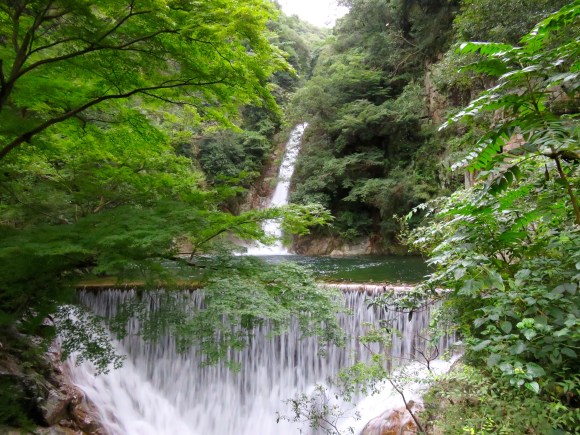
Japan’s major cities offer just about everything, but did you know that includes great nature trails? From forests and waterfalls to ancient temples and shrines, many of Japan’s best hiking trails are literally just a step off the bullet train. If you have a Japan Rail Pass, you’ll find it even harder to resist these hikes near Tokyo, Kyoto, Osaka, Kobe, Hiroshima and Fukuoka. Got a day–or even a half-day–to spare? You can still get your hike in!
These hiking routes make it convenient to explore Japan’s natural surroundings. No long drives to get out to the countryside, no great changes in altitude, and there’s always a good view waiting at the top. The trails are sign-posted, well-maintained, and many pass through historic districts and are tailored for sight-seeing by foot. You’ll find eating establishments, public toilets, lockers and even hot springs along the way on some of them. In short, Japan is a day-hikers dream! And if you like to run, these hiking courses make great running trails too.
You’ll want to be prepared to hike up a bit of vertical on these trails, but we’re guessing that a few inclines aren’t going to hold you back!
1. Kobe–Nunobiki Falls 布引の滝
We start off with the dream hike–just out the North entrance of Shin-Kobe Station, this one is so convenient, you’d be lazy not to do it. Thanks to Japan’s abundant rainfall and lush mountains, you’ll find waterfalls almost everywhere you go. The Nunobiki Waterfall hike offers three falls along the way. I get off the Shinkansen here just to do this hike, then I get back on and continue my journey. It’s just too good to pass up.
It turns out that this is a favorite run of the Kobe Hash House Harriers too, according to veteran hasher “Speedy Peety.” There is a sign at the bottom of the course and you’ll pass a series of waterfalls before you get to the top of the hill.
▼ The Nunobiki Falls trail is all paved, in some way or another, and is all uphill.
At the top of the trail is the “Herb Garden.” If you are lazy, and are fine with that, you can take the ropeway to the top and walk back down via the falls. Herb Garden hours are 10:00 a.m. to 5:00 p.m (but the last gondola ride is at 4:30).
If you want to hike further, pass the herb garden gates (on your right) and just down on the left is a small trail that will take you around the Nunobiki Reservoir and back down a path that eventually hooks up with the original trail. At the bottom of the Nunobiki Falls Trail there is another option to walk to the Kitano tourist district. It’s a short 1.1 km (half-mile or so) walk through the forest and a much more interesting way to get to Kitano than taking the train! Reward yourself at the unique Starbucks there.
You’ll find a map of the Nunobiki Falls course here
Tip: The entrance to the trail is underneath the station, through an underpass that looks like it definitely doesn’t lead to a hiking course.
2. Kyoto–The Kyoto Trail 京都一周トレイル
▼ The Kyoto Trail starts at Fushimi Inari
This trail is another dream trail as it passes over bridges and gorges, through historic towns and bamboo forests, past roadside deities, pagodas and waterfalls. You’ll be able to visit shrines and temples, including some of Kyoto’s major tourist sites such as Fushimi Inari Taisha Shrine, Kiomizu-dera Temple, and the Enrakuji Temple Complex (the latter being two of Japan’s 18 UNESCO World Heritage Sites). If you’re a tourist, you’re probably already headed there anyway, so why not take the scenic route?
▼ The signs to the trail can be hard to find, especially with crowds of tourists standing in front of them. Even if you do locate them, they’re likely to be in Japanese until you get onto the trail, which is English-friendly.
▼ Continue up through the torii gates, through a small graveyard, and look for the unassuming red gates, the only indication there is a trail. After that, you’ll begin to see sign posts which are very clear. From then on, you’ll never be wayward on the trail again–there will always be a signpost nearby.
The Kyoto Trail is about 110 kilometers (68 miles) long and encircles the city of Kyoto. You can enter the trail at any point from the city below. Along the path, you can drop down to any number of train stations along the foothills to get back to Kyoto Station or to your hotel.
▼ Little stone deities will help you along the way.
▼ This part of the trail through Mt. Hiezan alternates between dirt and paved paths.
Tip: The tourist information office at Kyoto Station sells maps of the Kyoto Trail for 300 to 500 yen each (US$2.50 to $4). These detailed maps divide the two sections of the trail further down into five bilingual maps: Higashiyama (東山), Kitayama West (北山西部), Kitayama East , (北山東部), Nishiyama 西山, and Keihoku (京北). There is also the Kyoto Trail Digest, a less detailed map of the entire route.
3. Nagano–Karuizawa Kyu Usui Pass 軽井沢
Karuizawa, a beautiful rural town and summer resort community outside Tokyo on the Hokuriku Shinkansen line, offers a plethora of walking, hiking, and cycling routes right out the gates of Karuizawa Station.
▼ The North Exit of Karuizawa Station
One of our favorites is the Kyu Usui Pass Sightseeing Trail, an 8-kilometer (5-mile) route that follows part of the ancient Nakasendo Trail, one of the five mountain walking routes that connected the capital of Edo (Tokyo) to the outlying provinces during the Edo Period (1603 – 1868).
The Kyu Usui Pass Sightseeing Trail, number 4 on the map is about a 20-minute walk from the station.
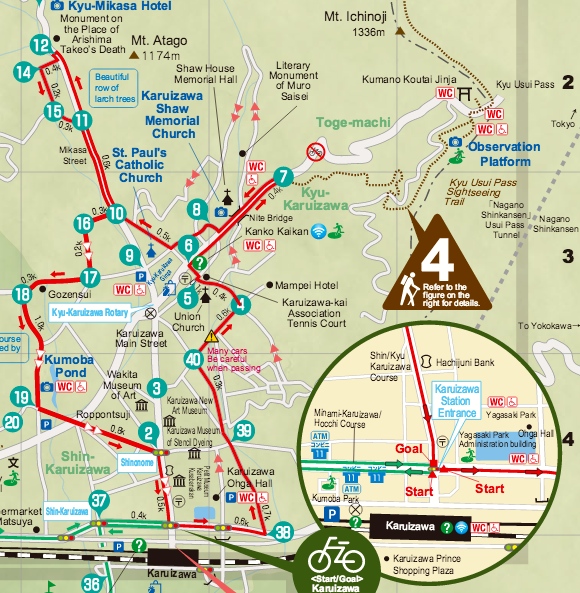
From the North side of Karuizawa Station, walk straight out the station until you get to the Kyu Kuruizawa Rotary intersection. Turn right towards the post office and you’re on your way to the trailhead. You’ll pass a public restroom and an information booth. Cross a bridge and you’ll be at the trailhead. The route also passes near Kumano Kotei Jinja shrine. There is an observation platform at 1,205 meters (almost 4,000 feet), a popular place to watch the sunset that also offers views of Mount Yatsugatake and Mount Myogi.
Download the complete map as well as other helpful information from the Japan National Tourism Organization.
Tip: Try the Kose Onsen hot spring after a day on the trail.
4. Hiroshima Peace Pagoda and Mount Futaba 二葉山
Our friends over at Get Hiroshima, who are avid hikers and trail runners, introduce a trail that leaves right from the Hiroshima Shinkansen station. Head to the trail that goes up to the Peace Pagoda on Mount Futaba (139 meters/456 feet), just a few hundred meters from the north side of the station. This trail takes you through primordial forest, a tunnel of torii gates and rewards you with great views over the city and the picturesque Seto Inland Sea.
▼ The city of Hiroshima as seen from Mount Futaba, with the Seto Inland Sea in the background.
▼ You hike past this camphor tree that survived the A-bomb blast despite being just 2 kilometers (1.2 miles) from the hypocenter.
Tip: Hiroshima is celebrating 70 years of peace and recovery after the Atomic Bomb. They are asking people to join in remembering Hiroshima’s history, celebrating its recovery and enjoying the great city it has become by tagging their photos and posts with #Hiroshima70. What a great way to get involved and promote world peace! Find out more about the digital stamp rally.
5. Osaka–Minou Koen 箕面公演
Okay, this isn’t exactly right off the Shinkansen line, but hey, it’s Osaka, with a population of 19 million people who are known for “kuiadore,” it’s not surprising that you’ll need to hop on a train to get beyond all the restaurants and into some real nature.
I was initially put off by the 25-minute train ride from Shin-Osaka station, which includes one line transfer, but after actually doing it I can assure you it’s a cinch. The country railroad stations are easy to navigate and are well sign-posted. The end of the Takarazuka Line drops you off at Minou Koen, part of a quasi national park.
▼ This short course is all gradual uphill but paved.
At Minou Station there is a tourist office but you don’t really need it. Just head up the street perpendicular to the station, and 2.7 kilometers (about a mile and a half) later, you’ll be at the waterfall. There and back is just over 5 kilometers, so if that’s a bit too short head up further beyond the waterfall to the Tokai Nature Trail, which extends 1,697 kilometers (1,054 miles) all the way to Tokyo! For that, however, you’ll want a map which is available at the tourist office next to Minou Station for 300 yen.
▼ The nice thing about the more touristy routes is the conveniences, such as an ice cream machine (always a welcome sight).
Tip: There’s an insectarium along the route to the waterfall, just in case you haven’t met enough insects outside already.
Bonus Trail!
6. Fukuoka–Mt. Tachibana 立花山 367 meters (1,204 feet) and Mt. Mikatzuki 三日月山 272 meters (892 feet)
A 36-minute train ride from Hakata Station is the start of the Tachibanayama trail. Nick Szasz, who publishes Fukuoka Now, a website passionate about hiking in Fukuoka, provides detailed information on trails as well as tips on what to take on a hike with you, where water sources are for each hike, and other pertinent information, including photos with arrows to show the way.
After hiking Mount Tachibana you can continue on to the easier hike up Mount Mikazuki.
For more details on the Tachibanayama and Mikazukiyama hikes, click here. More hikes in Fukuoka can be found at Fukuoka Now.
Tip: Fukuoka is known for its original goboten udon (udon noodles with burdock tempura). Be sure to try it!
Good luck and see you out on the trails!
H/T to Bob Poulson at Nanban Rengo, for the information on Karuizawa
All images ©Amy Chavez/RocketNews24 unless otherwise noted

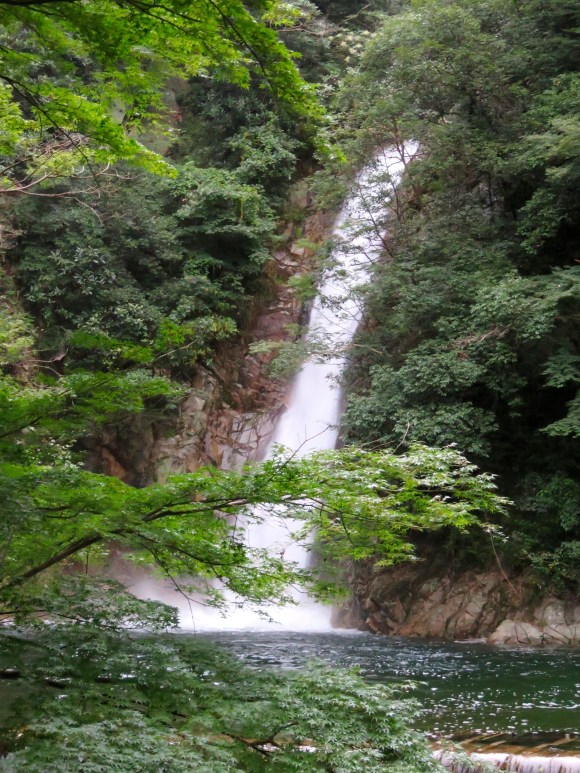
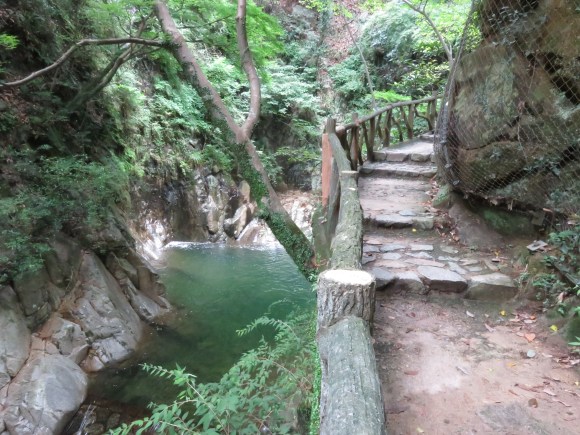
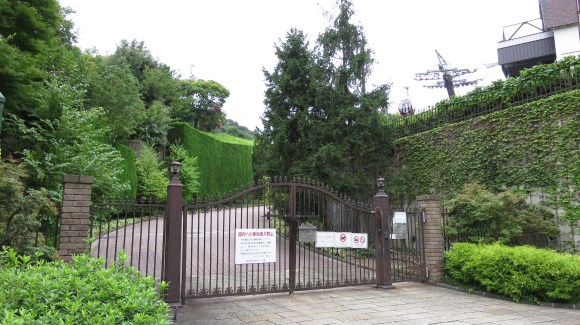
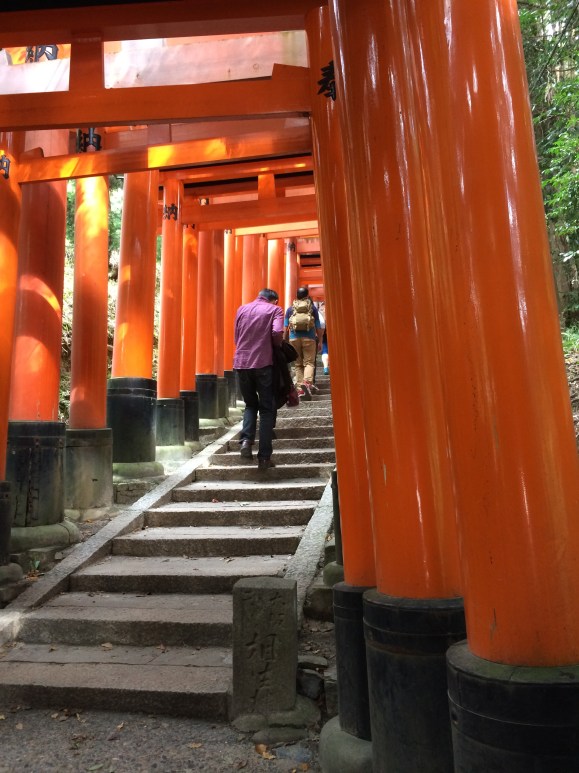
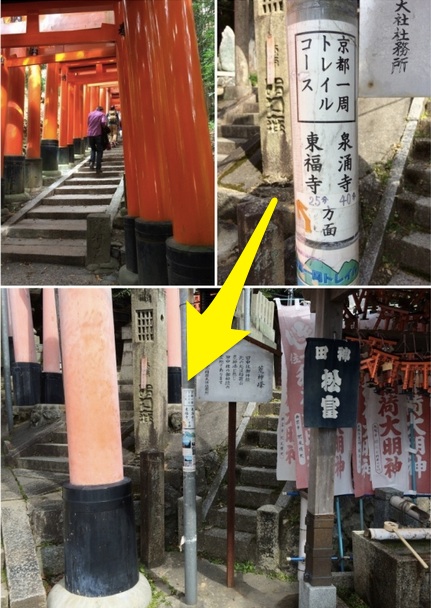
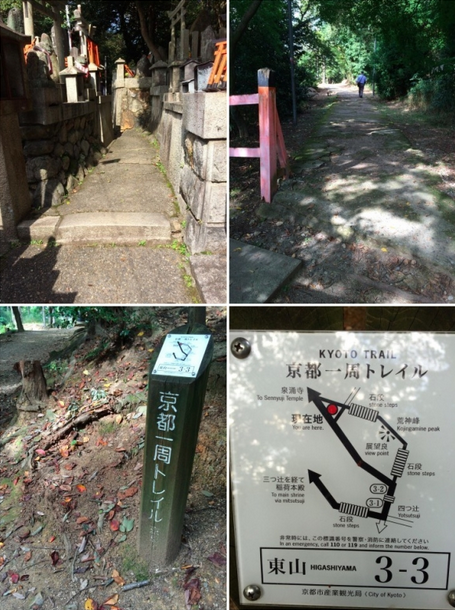
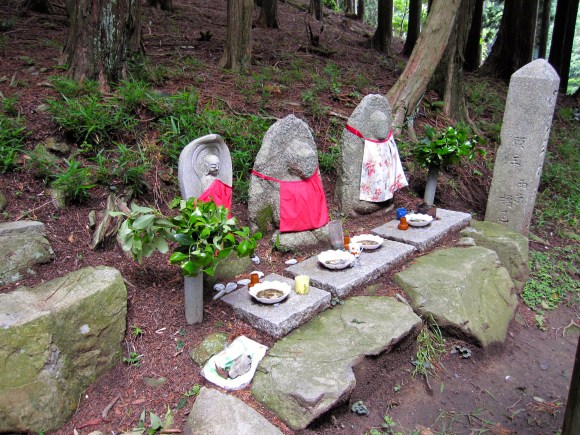
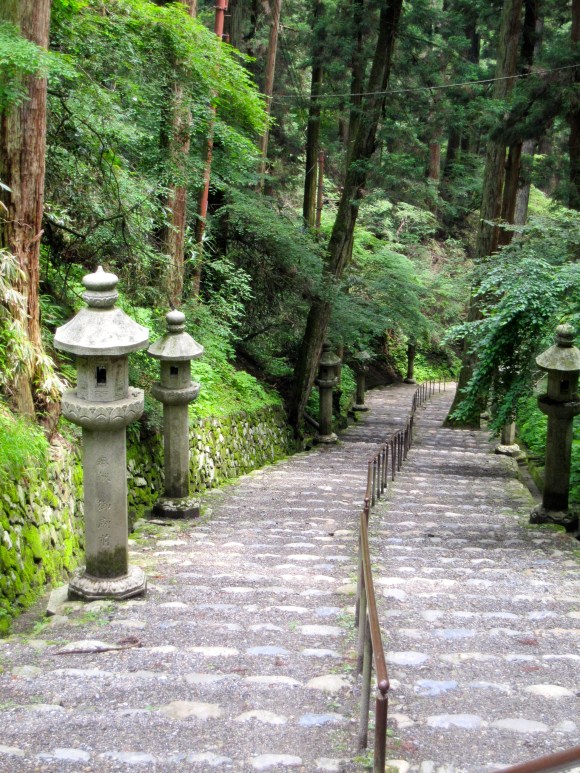
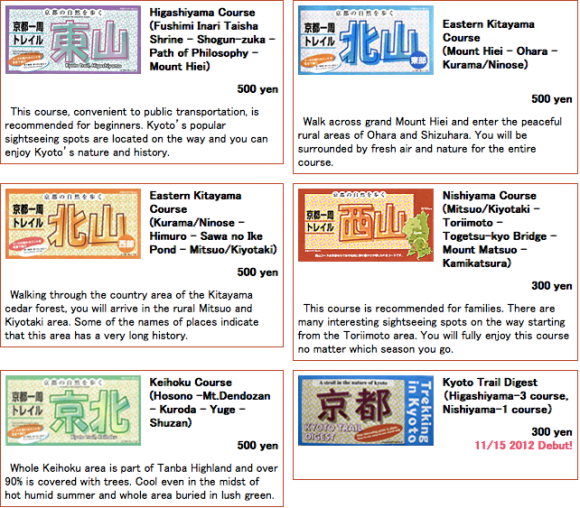
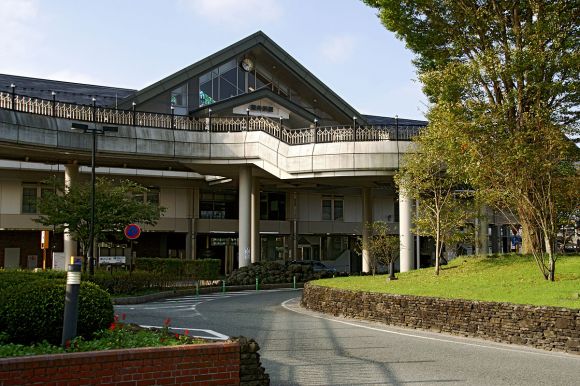
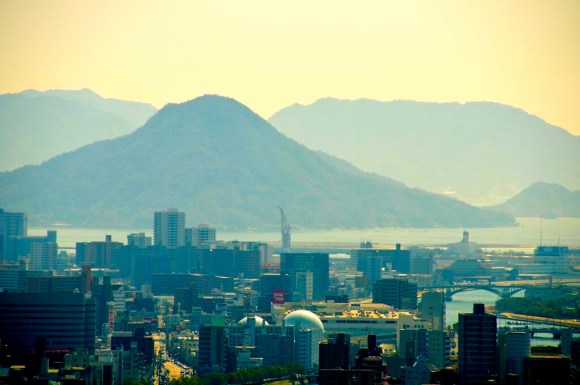

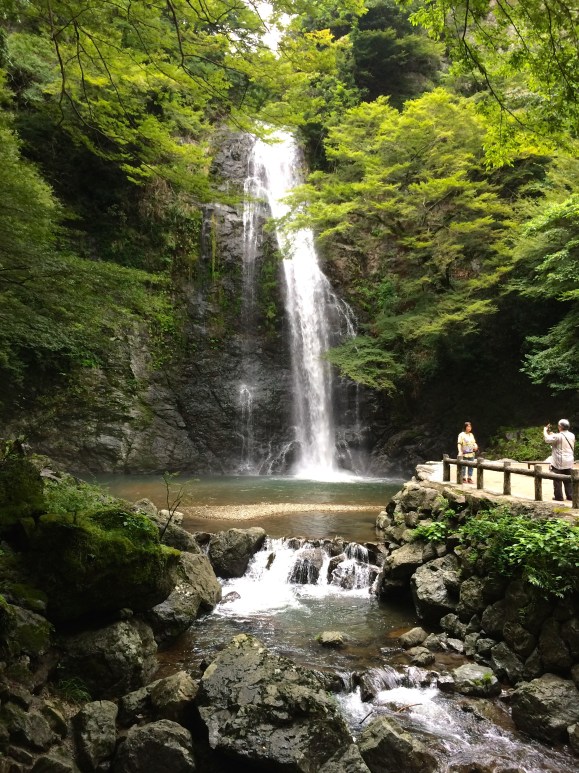
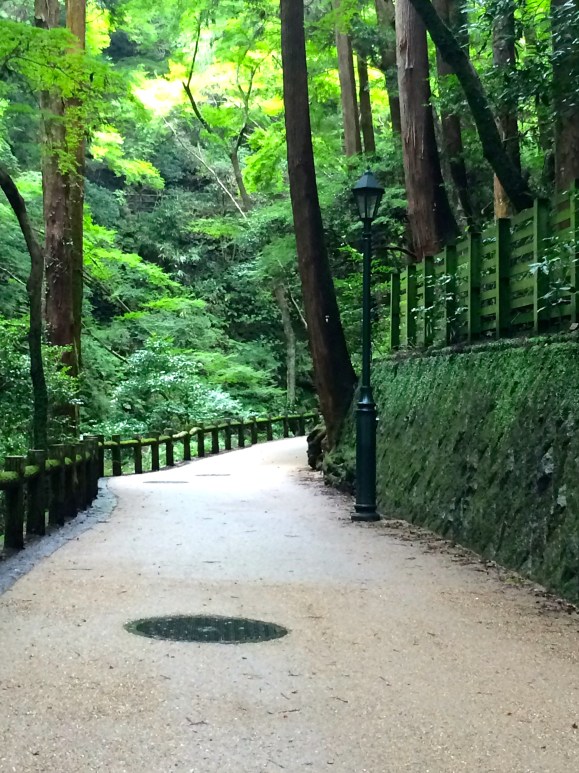
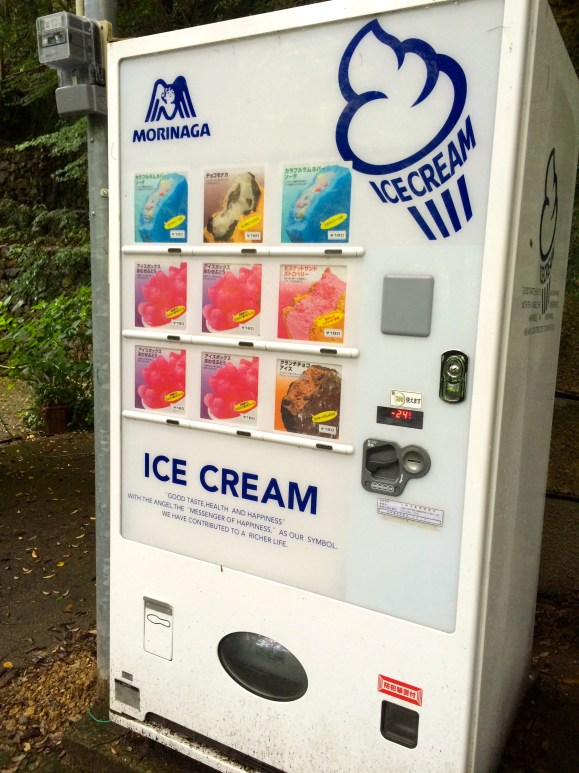
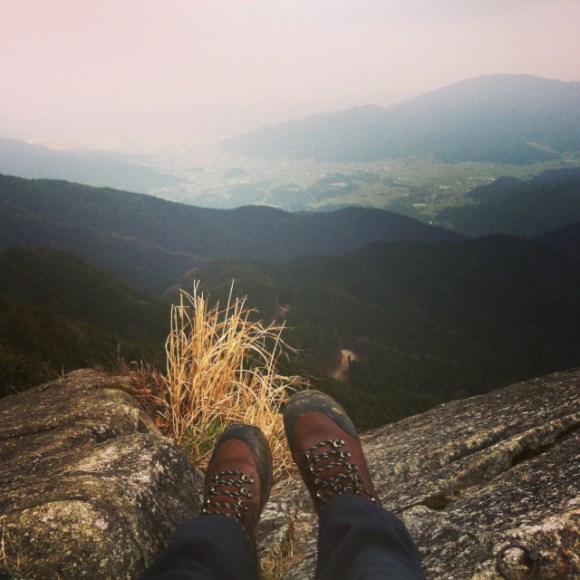
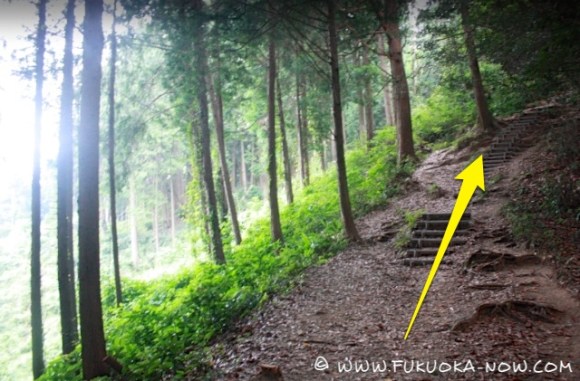
 Japan’s five easiest-to-get-lost-on mountain trails are like alpine brain teasers【Photos】
Japan’s five easiest-to-get-lost-on mountain trails are like alpine brain teasers【Photos】 Mt. Fuji is officially closed for the year
Mt. Fuji is officially closed for the year Mount Fuji has become so congested with tourists that it has reached breaking point
Mount Fuji has become so congested with tourists that it has reached breaking point Barricades placed on Mt. Fuji as mountain officially closes because of coronavirus【Video】
Barricades placed on Mt. Fuji as mountain officially closes because of coronavirus【Video】 Human traffic jam on Mt. Fuji shows why weekdays are the best days to hike the symbol of Japan
Human traffic jam on Mt. Fuji shows why weekdays are the best days to hike the symbol of Japan McDonald’s new Happy Meals offer up cute and practical Sanrio lifestyle goods
McDonald’s new Happy Meals offer up cute and practical Sanrio lifestyle goods Studio Ghibli glasses cases let anime characters keep an eye on your spectacles
Studio Ghibli glasses cases let anime characters keep an eye on your spectacles All-you-can-drink Starbucks and amazing views part of Tokyo’s new 170 meter-high sky lounge
All-you-can-drink Starbucks and amazing views part of Tokyo’s new 170 meter-high sky lounge McDonald’s Japan releases a pancake pie for new retro kissaten coffeeshop series
McDonald’s Japan releases a pancake pie for new retro kissaten coffeeshop series Starbucks reopens at Shibuya Scramble Crossing with new look and design concept
Starbucks reopens at Shibuya Scramble Crossing with new look and design concept Beautiful Sailor Moon manhole cover coasters being given out for free by Tokyo tourist center
Beautiful Sailor Moon manhole cover coasters being given out for free by Tokyo tourist center More foreign tourists than ever before in history visited Japan last month
More foreign tourists than ever before in history visited Japan last month Coordinating a whole outfit with nothing but clothes from Japanese convenience store Family Mart
Coordinating a whole outfit with nothing but clothes from Japanese convenience store Family Mart Kyoto’s 100 Demons yokai monster parade returns!
Kyoto’s 100 Demons yokai monster parade returns! Super Nintendo World expansion gets delayed for several months at Universal Studios Japan
Super Nintendo World expansion gets delayed for several months at Universal Studios Japan Disney princesses get official manga makeovers for Manga Princess Cafe opening in Tokyo
Disney princesses get official manga makeovers for Manga Princess Cafe opening in Tokyo Beautiful new Final Fantasy T-shirt collection on the way from Uniqlo【Photos】
Beautiful new Final Fantasy T-shirt collection on the way from Uniqlo【Photos】 Is the new Shinkansen Train Desk ticket worth it?
Is the new Shinkansen Train Desk ticket worth it? Foreign English teachers in Japan pick their favorite Japanese-language phrases【Survey】
Foreign English teachers in Japan pick their favorite Japanese-language phrases【Survey】 Japanese convenience store packs a whole bento into an onigiri rice ball
Japanese convenience store packs a whole bento into an onigiri rice ball We try out “Chan Ramen”, an underground type of ramen popular in the ramen community
We try out “Chan Ramen”, an underground type of ramen popular in the ramen community Studio Ghibli releases Kiki’s Delivery Service chocolate cake pouches in Japan
Studio Ghibli releases Kiki’s Delivery Service chocolate cake pouches in Japan Japan’s bone-breaking and record-breaking roller coaster is permanently shutting down
Japan’s bone-breaking and record-breaking roller coaster is permanently shutting down New definition of “Japanese whiskey” goes into effect to prevent fakes from fooling overseas buyers
New definition of “Japanese whiskey” goes into effect to prevent fakes from fooling overseas buyers Our Japanese reporter visits Costco in the U.S., finds super American and very Japanese things
Our Japanese reporter visits Costco in the U.S., finds super American and very Japanese things Studio Ghibli unveils Mother’s Day gift set that captures the love in My Neighbour Totoro
Studio Ghibli unveils Mother’s Day gift set that captures the love in My Neighbour Totoro Foreign passenger shoves conductor on one of the last full runs for Japan’s Thunderbird train
Foreign passenger shoves conductor on one of the last full runs for Japan’s Thunderbird train Domino’s Japan now sells…pizza ears?
Domino’s Japan now sells…pizza ears? New Japanese KitKat flavour stars Sanrio characters, including Hello Kitty
New Japanese KitKat flavour stars Sanrio characters, including Hello Kitty Kyoto creates new for-tourist buses to address overtourism with higher prices, faster rides
Kyoto creates new for-tourist buses to address overtourism with higher prices, faster rides Sales of Japan’s most convenient train ticket/shopping payment cards suspended indefinitely
Sales of Japan’s most convenient train ticket/shopping payment cards suspended indefinitely Sold-out Studio Ghibli desktop humidifiers are back so Totoro can help you through the dry season
Sold-out Studio Ghibli desktop humidifiers are back so Totoro can help you through the dry season Japanese government to make first change to romanization spelling rules since the 1950s
Japanese government to make first change to romanization spelling rules since the 1950s Ghibli founders Toshio Suzuki and Hayao Miyazaki contribute to Japanese whisky Totoro label design
Ghibli founders Toshio Suzuki and Hayao Miyazaki contribute to Japanese whisky Totoro label design Doraemon found buried at sea as scene from 1993 anime becomes real life【Photos】
Doraemon found buried at sea as scene from 1993 anime becomes real life【Photos】 Tokyo’s most famous Starbucks is closed
Tokyo’s most famous Starbucks is closed One Piece characters’ nationalities revealed, but fans have mixed opinions
One Piece characters’ nationalities revealed, but fans have mixed opinions We asked a Uniqlo employee what four things we should buy and their suggestions didn’t disappoint
We asked a Uniqlo employee what four things we should buy and their suggestions didn’t disappoint Princesses, fruits, and blacksmiths: Study reveals the 30 most unusual family names in Japan
Princesses, fruits, and blacksmiths: Study reveals the 30 most unusual family names in Japan Shiratani Unsuikyo: The breathtaking anime setting where Princess Mononoke was born
Shiratani Unsuikyo: The breathtaking anime setting where Princess Mononoke was born Hike from the sea to the peak of Mt. Fuji with new bilingual English/Japanese guide map series
Hike from the sea to the peak of Mt. Fuji with new bilingual English/Japanese guide map series Hiking restrictions result in huge drop in climbing accidents, with zero on Mt. Fuji
Hiking restrictions result in huge drop in climbing accidents, with zero on Mt. Fuji Beautiful forest in southern Japan will spirit you away to another world
Beautiful forest in southern Japan will spirit you away to another world Think you’ve had every type of tempura? Not until you’ve eaten deep-fried maple leaves
Think you’ve had every type of tempura? Not until you’ve eaten deep-fried maple leaves Love Japanese hot springs? At Nakadake Onsen in Hokkaido, you can dig your own!
Love Japanese hot springs? At Nakadake Onsen in Hokkaido, you can dig your own! U.S. servicemen’s hike on Mount Fuji turns into rescue mission, netizens are awed and grateful
U.S. servicemen’s hike on Mount Fuji turns into rescue mission, netizens are awed and grateful 10 gorgeous, must-visit places to see the autumn leaves in Japan
10 gorgeous, must-visit places to see the autumn leaves in Japan 7 incredible Japanese destinations that tourists haven’t discovered yet
7 incredible Japanese destinations that tourists haven’t discovered yet Japanese-style Rilakkuma teahouse opens in one of the most beautiful places in Japan
Japanese-style Rilakkuma teahouse opens in one of the most beautiful places in Japan The only path to this Nagasaki Shinto shrine gets swallowed by the sea every day【Video】
The only path to this Nagasaki Shinto shrine gets swallowed by the sea every day【Video】 Huge price hike for Japan Rail Pass triggers huge drop in foreign travelers who’ll buy it【Survey】
Huge price hike for Japan Rail Pass triggers huge drop in foreign travelers who’ll buy it【Survey】 When the pandemic is over…Beautiful photos of places Japan travelers want to visit after corona
When the pandemic is over…Beautiful photos of places Japan travelers want to visit after corona Secret Tokyo night view spot is also a great meeting place away from the crowds
Secret Tokyo night view spot is also a great meeting place away from the crowds Mt. Fuji is now open again following 2020 shutdown
Mt. Fuji is now open again following 2020 shutdown
Leave a Reply